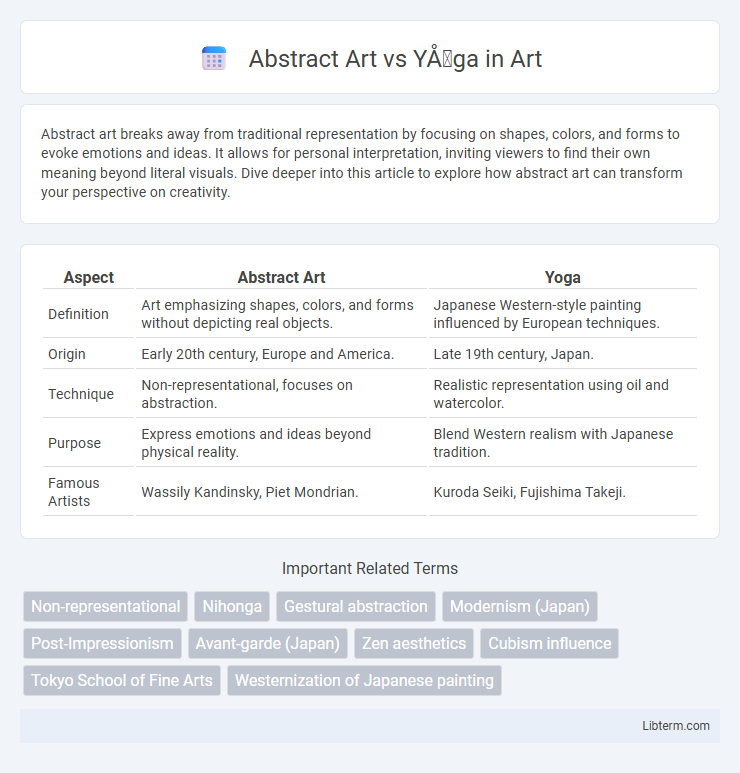Abstract art breaks away from traditional representation by focusing on shapes, colors, and forms to evoke emotions and ideas. It allows for personal interpretation, inviting viewers to find their own meaning beyond literal visuals. Dive deeper into this article to explore how abstract art can transform your perspective on creativity.
Table of Comparison
| Aspect | Abstract Art | Yoga |
|---|---|---|
| Definition | Art emphasizing shapes, colors, and forms without depicting real objects. | Japanese Western-style painting influenced by European techniques. |
| Origin | Early 20th century, Europe and America. | Late 19th century, Japan. |
| Technique | Non-representational, focuses on abstraction. | Realistic representation using oil and watercolor. |
| Purpose | Express emotions and ideas beyond physical reality. | Blend Western realism with Japanese tradition. |
| Famous Artists | Wassily Kandinsky, Piet Mondrian. | Kuroda Seiki, Fujishima Takeji. |
Introduction to Abstract Art and Yōga
Abstract Art emphasizes non-representational forms, prioritizing colors, shapes, and textures to evoke emotions and ideas beyond literal depiction. Yoga, a style of Western-influenced Japanese painting, integrates realism, perspective, and shading techniques with traditional Japanese themes, reflecting cultural and artistic synthesis. Both movements significantly shaped modern art by challenging conventional boundaries and exploring new aesthetic expressions.
Historical Backgrounds: Origins and Development
Abstract Art originated in the early 20th century, emphasizing non-representational forms rooted in Western modernism and movements such as Cubism and Expressionism. Yoga, emerging during Japan's Meiji era (1868-1912), represents the adoption and adaptation of Western-style oil painting techniques, blending European realism with Japanese themes. Both art forms reflect cross-cultural exchanges but differ as Abstract Art breaks from figurative representation while Yoga integrates Western methods within Japanese artistic traditions.
Philosophical Foundations and Influences
Abstract art emphasizes non-representational forms and emotional expression, drawing from early 20th-century Western philosophies like Kandinsky's spiritualism and Wassily Kandinsky's theory of color and form. Yoga, a Japan-based Western-style painting movement, integrates realism and perspective with Zen Buddhist concepts and Confucian aesthetics, emphasizing harmony and nature. Both movements reflect distinct cultural philosophies: abstract art pursues universal spirituality and subjective experience, while Yoga balances Western techniques with Japanese ethical and naturalistic values.
Key Figures and Artists
Abstract Art features influential artists like Wassily Kandinsky, Piet Mondrian, and Jackson Pollock who pioneered non-representational forms, emphasizing color, shape, and emotion. Yoga, a Japanese Western-style painting movement, includes key figures such as Kuroda Seiki, Fujishima Takeji, and Nakamura Tsune, who integrated Western techniques with Japanese aesthetics. Both movements reflect cross-cultural exchanges and diverse approaches to form and expression in modern art history.
Techniques and Materials Used
Abstract art employs non-representational techniques using materials such as acrylics, oils, and mixed media on canvas or paper to emphasize color, shape, and texture without depicting real-world objects. Yoga, a Japanese style influenced by Western painting, utilizes realistic techniques involving oil paints on canvas, focusing on lifelike representation, perspective, and shading to capture subjects accurately. The contrast in techniques highlights abstract art's focus on emotional expression through form and color, while Yoga prioritizes technical skill and realism through traditional Western materials and methods.
Visual Language: Form, Color, and Composition
Abstract art emphasizes non-representational forms, utilizing bold colors and dynamic compositions to evoke emotions beyond literal interpretation. Yoga, a style of Western-influenced Japanese painting, combines realistic forms with subtle color gradations and balanced composition, blending traditional Japanese aesthetics with European techniques. The visual language of Abstract art prioritizes expressive freedom, whereas Yoga focuses on harmonious structure and detailed representation.
Cultural Contexts and Symbolism
Abstract art, emerging in the early 20th century, emphasizes non-representational forms and explores emotions through color, shape, and texture, reflecting Western modernist movements and often symbolizing individual freedom and universal concepts. Yoga, the Japanese Western-style painting tradition developed in the late 19th and early 20th centuries, incorporates realistic techniques and perspectives influenced by European realism while symbolizing Japan's cultural modernization and dialogue between tradition and Western influence. Both art forms use symbolism to convey deeper meanings, with Abstract art focusing on inner psychological states and Yoga blending cultural identity and historical narrative within a modernized Japan.
Reception and Criticism in Art Circles
Abstract Art often receives acclaim for its emphasis on emotional expression and visual experimentation, establishing a dynamic dialogue within Western and global art circles. Yoga, characterized by its adoption of Western techniques and realism in Japanese art, has historically faced criticism for its perceived Westernization and struggle to maintain a distinct cultural identity. The reception of both styles highlights ongoing debates about tradition versus innovation, with Abstract Art praised for pushing boundaries and Yoga scrutinized for balancing cultural authenticity and modernization.
Contemporary Interpretations and Legacy
Abstract Art emphasizes non-representational forms, exploring color, shape, and emotion to challenge traditional aesthetics, while Yoga integrates Western oil painting techniques with Japanese themes, fostering cultural hybridity in contemporary works. Contemporary interpretations of Abstract Art often highlight individual expression and spiritual exploration, whereas modern Yoga continues to evolve by blending realism with symbolic motifs that reflect Japan's socio-cultural landscape. The legacy of both movements significantly shapes global art discourse, with Abstract Art influencing international avant-garde practices and Yoga preserving a unique fusion that bridges East and West in modern artistic identity.
Conclusion: Bridging East and West in Modern Art
Abstract Art and Yoga represent distinct yet complementary approaches to modern art, with Abstract Art emphasizing non-representational forms and Yoga blending Western techniques with Japanese aesthetics. This convergence fosters a dynamic dialogue that challenges traditional boundaries and enriches contemporary creativity. Bridging these styles highlights the evolving intercultural exchange that shapes global art movements today.
Abstract Art Infographic

 libterm.com
libterm.com